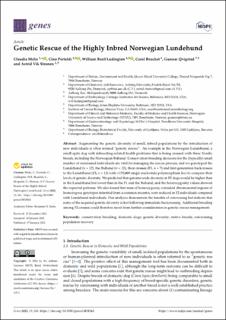Genetic Rescue of the Highly Inbred Norwegian Lundehund
| dc.contributor.author | Melis, Claudia | |
| dc.contributor.author | Pertoldi, Cino | |
| dc.contributor.author | Ludington, William Basil | |
| dc.contributor.author | Beuchat, Carol | |
| dc.contributor.author | Qvigstad, Gunnar | |
| dc.contributor.author | Stronen, Astrid Vik | |
| dc.date.accessioned | 2022-09-07T06:21:13Z | |
| dc.date.available | 2022-09-07T06:21:13Z | |
| dc.date.created | 2022-01-19T10:54:28Z | |
| dc.date.issued | 2022 | |
| dc.identifier.citation | Genes. 2022, 13 (1), 1-12. | en_US |
| dc.identifier.issn | 2073-4425 | |
| dc.identifier.uri | https://hdl.handle.net/11250/3016122 | |
| dc.description.abstract | Augmenting the genetic diversity of small, inbred populations by the introduction of new individuals is often termed “genetic rescue“. An example is the Norwegian Lundehund, a small spitz dog with inbreeding-related health problems that is being crossed with three Nordic breeds, in-cluding the Norwegian Buhund. Conservation breeding decisions for the (typically) small number of outcrossed individuals are vital for managing the rescue process, and we genotyped the Lundehund (n = 12), the Buhund (n = 12), their crosses (F1, n = 7) and first-generation backcrosses to the Lundehund (F2, n = 12) with >170,000 single nucleotide polymorphism loci to compare their levels of genetic diversity. We predicted that genome-wide diversity in F2 dogs would be higher than in the Lundehund but lower than in the F1 and the Buhund, and the heterozygosity values showed the expected patterns. We also found that runs of homozygosity, extended chromosomal regions of homozygous genotypes inherited from a common ancestor, were reduced in F2 individuals compared with Lundehund individuals. Our analyses demonstrate the benefits of outcrossing but indicate that some of the acquired genetic diversity is lost following immediate backcrossing. Additional breeding among F2 crosses could therefore merit from further consideration in genetic rescue management. | en_US |
| dc.language.iso | eng | en_US |
| dc.publisher | MDPI | en_US |
| dc.rights | Navngivelse 4.0 Internasjonal | * |
| dc.rights.uri | http://creativecommons.org/licenses/by/4.0/deed.no | * |
| dc.subject | Hunder | en_US |
| dc.subject | Dogs | en_US |
| dc.subject | Genetisk diversitet | en_US |
| dc.subject | Genetic diversity | en_US |
| dc.subject | Innavl | en_US |
| dc.subject | Interbreeding | en_US |
| dc.subject | Bevaringsbiologi | en_US |
| dc.subject | Conservation biology | en_US |
| dc.title | Genetic Rescue of the Highly Inbred Norwegian Lundehund | en_US |
| dc.type | Journal article | en_US |
| dc.type | Peer reviewed | en_US |
| dc.description.version | publishedVersion | en_US |
| dc.source.pagenumber | 1-12 | en_US |
| dc.source.volume | 13 | en_US |
| dc.source.journal | Genes | en_US |
| dc.source.issue | 1 | en_US |
| dc.identifier.doi | 10.3390/genes13010163 | |
| dc.identifier.cristin | 1984445 | |
| dc.relation.project | Peder Sather Center: Advanced study grant award | en_US |
| cristin.ispublished | true | |
| cristin.fulltext | original | |
| cristin.qualitycode | 1 |

